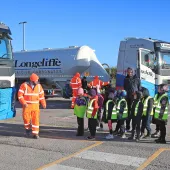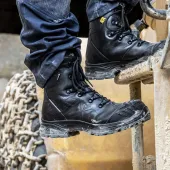Health Authority Risk
Even Punch and Judy men are getting risk assessments today. So to continue the theme started by Bryson above, MQR’s regular Health Authority Colin Nottage offers firms advice on how to say “that’s the way to do it”.
Risk assessment is the foundation of successful health and safety management and if it is done well it can have an enormous effect in reducing the chance of accidents and incidents in the workplace.
However, many people either do nothing or over complicate the process.
The Health and Safety Executive (HSE) are currently running a campaign on risk assessment after a Punch and Judy show was asked to complete risk assessments for a local fair (Oh no he didn’t! The HSE maintains the Punch and Judy man in question received a standard letter from an event organiser asking him to submit a health and safety risk assessment and when he questioned the need for it, they told him no paperwork was required. In August the HSE released a poster advertising such – Ed).
It is not surprising that clients ask for these assessments because they believe they are covered if something goes wrong.
In my experience it is always possible to find fault in any document if you look hard enough, so having a written risk assessment is only part of the answer.
What is important is that management and employees are trying to assess tasks to minimise the chance of an incident in the first place. They also need to have a simple, effective process in place for identifying the tasks that are going on at a site, a basic assessment on whether there is a significant risk or not, and where there is a risk, that significant documentation is in place. HSE guidance is clear:
- if there is genuinely no significant risk then nothing needs to be written down.
However, if a risk assessment is required, then it needs to be kept simple. It should also involve the people undertaking the activity and should be relevant to the site-specific task.
Risk assessments are about looking at the likelihood of an incident occurring and the severity and the number of people that are affected. It is also about identifying what controls are in place and whether they are effective. If the controls are not effective then the assessment needs to consider what else needs to be done to make the job safe.
Enlisting the help of PETE and ERIC
When completing risk assessments there are a couple of simple things to remember, namely PETE and ERIC. Also known as a dynamic risk assessment.
PETE
In case you hadn’t already realised, PETE and ERIC are acronyms. Let’s start with PETE: People, Equipment, Task, Environment.
People is all about looking at the people who are going to complete the task. Questions you need to ask your self: are they competent and physically able to perform the
duties?
Equipment. Is the equipment suitable? Has it been inspected and tested as appropriate?
Task. What is the task? What are the main hazards associated with the task?
Environment: Is the work being undertaken at height, outdoors, next to vehicle routes or in confined spaces?
ERIC
Once you have had a look at PETE it is time to consider ERIC for the control measures. This stands for Eliminate, Reduce, Isolate and Control.
Eliminate. Can the task be prevented completely? If so, ensure it is if the risks are too high.
Reduce. If the task can’t be eliminated then what can be undertaken to reduce the impact or exposure?
Isolate. Can this reduced hazard be isolated? This may be electrical, pneumatic or hydraulic interlocks or stored energy from gravity.
Control. When you have gone through all the above you need to ask what further controls are required to minimise the hazard.
Remember, risk assessment does not need to be complicated. Keep it simple. Make sure the people who are doing the task are involved in the process. If a significant risk is present then document the risk but make sure you are comfortable that there is a good initial task vetting process in place.
If in doubt, the HSE has written what it sees as the principles of risk management. A list of what assessment should and shouldn’t be.
It states that good assessment is about ensuring that workers and the public are properly protected and providing an overall benefit to society by balancing benefits
and risks.
It is also about enabling innovation and learning not stifling them and ensuring that those who create risks manage them responsibly. It is also about individuals understanding that as well as the right to protection, they also have to exercise responsibility.
It is not about creating a totally risk free society, generating useless paperwork or scaring people by exaggerating trivial risks, it says. It is about protecting people.
Colin: 07799 656303








